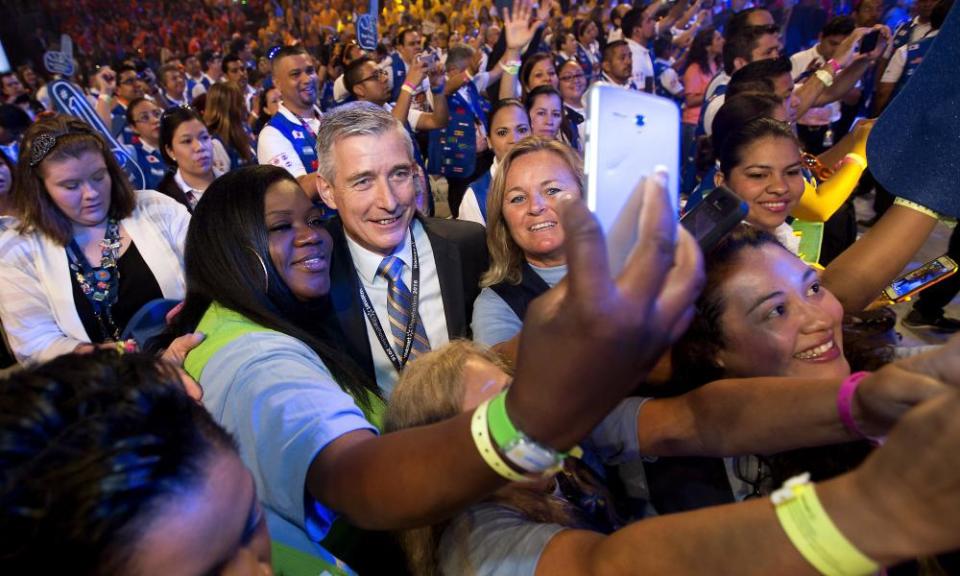Walmart invests billions to buy from women-owned businesses – but is it enough?

Walmart announced Wednesday it has achieved its goal to buy $20bn worth of goods and services from women-owned businesses in the US over five years. The company also conceded that it’s failed to reach another goal set around the same time: to double the amount of products and services sourced from women-owned companies outside of the country.
The mixed success shows the challenges for big companies to narrow the gaping gender gap. While Walmart’s initiative has doubled the amount of money it spends with women-owned suppliers, it’s still only 2% of the retailer’s global purchases. Yet that’s twice the global average retailers spend with women-owned businesses.
The retail giant launched the Global Women’s Economic Empowerment Initiative in 2011 to increase the number of its women-owned suppliers. The initiative also provided training and other services to female entrepreneurs.
As the world’s largest retailer, Walmart’s decision to take on gender equality or other sustainability work carries a significant weight among its competitors and suppliers.
Promoting women-owned business reflects not just the company’s values, its executives said. It’s also good for business, said Kathleen McLaughlin, chief sustainability officer for Walmart and president of the Walmart Foundation, which spearheaded the initiative.
“We’ve found that products from women-led companies have better sell-through rates and better margins,” McLaughlin said. She believes women entrepreneurs do well because they tend to get involved in businesses – especially food, apparel and toys – that can make use of their personal experiences.
Walmart’s finding corresponds with data compiled by American Express, which shows that the number of women-owned businesses in the US has grown 45% from 2007 to 2016, compared with a 9% increase in businesses owned by men. During that same time period, women-owned businesses saw 35% higher revenue increases than men-owned businesses.
The retail giant now buys products and services such as accounting and consulting from more than 1500 women-owned businesses worldwide, McLaughlin said. The company also has given out $134m of grants for training to 1 million women in its global supply chain and outside of it.
The initiative taught some good lessons for Walmart.
For example, the company underestimated the breadth of the challenges women entrepreneurs face in certain countries, McLaughlin said. It has managed to double the amount of money it spends with women-owned businesses in Mexico, but has otherwise struggled to increase international purchases from women-led companies.
“In China, for example, it’s taken us years just to identify the women-led businesses,” McLaughling said, because, she explained, there was no private or government data to help with the research. “In Japan, women haven’t traditionally been encouraged to start businesses, so we had to begin with pitch contests there to inspire women to participate.”
The company also has learned that creating a successful work environment for women involves more than just training female executives.
“About halfway through the factory program we realized we had to train men, too, to show them that they might need to change how they’re communicating with the women on their staffs,” McLaughlin said.
The struggle by large companies to close the gender gap internally or among their partners isn’t surprising, said Barbara Annis, co-author of the forthcoming book, Results at the Top. Initiatives like Walmart’s, although well intended, usually don’t do enough to reduce gender disparity, she said.
“Companies tend to say, ‘Let’s create programs for women or networks or training’, and all of that stuff does have an impact on engagement and feeling valued, so in that sense it’s great,” Annis said. “But it has zero correlation to advancement. And that’s where a lot of times these sorts of initiatives end up being window dressing that has very little lasting impact.”
McLaughlin said Walmart understands the difficulties of creating a lasting change and seeks to intensify its effort to support women business leaders by asking its large, male-led suppliers to report on the gender makeup of employees on their key, internal teams.
“We didn’t set any quotas or requirements, we just asked them to share the information, and just through that we saw the diversity of those teams increase,” she said.
Walmart also announced Wednesday that it will join eight other multinational companies – Coca-Cola, Pepsi, Exxon-Mobil, General Mills, Campbell’s Soup, Procter & Gamble, Johnson & Johnson and Mondoleez – to commit to sourcing more from women-owned companies.
These companies plan to report their progress each year to the Women’s Business Enterprise National Council, a nonprofit in Washington DC that validates companies that are owned or operated by women, given that government agencies and the private sector run programs to promote women-owned businesses. The council will use the data to produce an annual report. McLaughlin said she hopes other companies will join the initiative as well.
Ariela Balk, founder and CEO of Smart & Sexy, a lingerie company in New York City, mentored women as part of Walmart’s initiative. She noted that the program opened the door, but it wasn’t meant to guarantee success.
“No one is asking for any special privileges and advantages,” said Balk, who has been selling her products to Walmart for more than a decade. “Business is tough. The customer votes and the best product wins.”

 Yahoo News
Yahoo News 